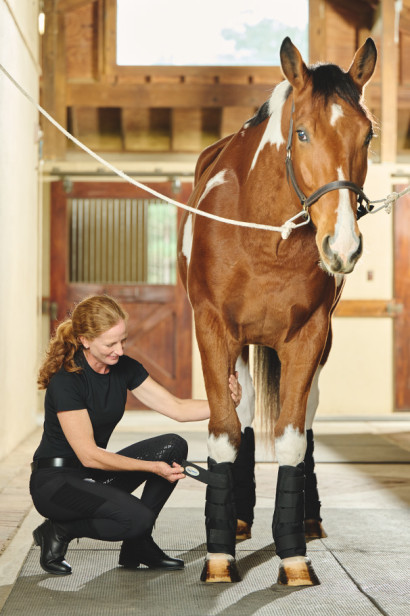Equine Therapy Success Stories: Real People, Real Psychological Transformations
Equine Therapy Success Stories: Real People, Real Psychological Transformations
Blog Article
Assessing the Efficiency of Laser Therapy in Horse Therapy for Injury Rehab
The assessment of laser treatment's performance in equine injury rehabilitation hinges on multiple elements, including recovery time, pain mitigation, and tissue regeneration. Veterinarians frequently observe remarkable outcomes with laser therapy compared to conventional approaches, placing it as an essential element in equine care.
Understanding Laser Treatment
Laser treatment has actually come to be a pivotal device in vet medication, specifically in the therapy of equine conditions. Known for its non-invasive nature and efficacy, laser treatment entails the application of certain wavelengths of light to promote cells fixing and reduce swelling. This restorative technique is progressively favored for its capacity to increase the healing process in steeds experiencing a variety of musculoskeletal injuries and persistent conditions.
The key mechanism behind laser treatment is its ability to boost cellular features. When laser light penetrates the skin, it is absorbed by mitochondria, the powerhouse of cells, which causes increased manufacturing of adenosine triphosphate (ATP) This biochemical energy boost facilitates mobile repair and regeneration. In addition, laser therapy advertises vasodilation, boosting blood circulation and oxygen shipment to broken tissues, therefore expediting healing.
In equine medication, laser treatment is specifically useful for conditions such as tendonitis, osteo arthritis, and wound recovery. The strategy is admired for its pain-relieving properties, allowing horses to reclaim flexibility and function a lot more swiftly. Vets also appreciate its minimal adverse effects contrasted to various other therapy methods, making it a reputable and secure alternative for equine care.

Just How Laser Treatment Functions

Upon absorption, these photons activate a series of biochemical changes, enhancing mitochondrial feature and causing boosted adenosine triphosphate (ATP) production. This rise in ATP increases cellular metabolism, advertising cells repair work and regeneration. In addition, laser therapy modulates inflammatory feedbacks by impacting cytokine levels and reducing oxidative stress and anxiety, consequently relieving pain and swelling.
One more substantial element of laser treatment is its function in enhancing microcirculation. The treatment promotes vasodilation, improving blood circulation and oxygen shipment to broken tissues (Equine Therapy). This facilitates the elimination of cellular particles and supports the expansion of fibroblasts and collagen synthesis, essential for injury healing
Professional Proof
The efficacy of laser treatment in equine treatment has been corroborated via numerous clinical studies, showcasing its restorative prospective throughout an array of problems. A study conducted by Turner et al. (2012) demonstrated that horses treated with low-level laser therapy (LLLT) for tendon injuries displayed sped up Check This Out recovery contrasted to those obtaining standard therapies.
In a similar way, study by Johnson and colleagues (2015) concentrated on equine muscle injuries, revealing that laser therapy dramatically quickened muscular tissue fiber regrowth and lowered muscular tissue rigidity. These searchings for were substantiated by histological analyses revealing improved muscle mass cells company. Clinical analyses have actually shown that laser treatment can relieve persistent conditions such as osteoarthritis. A study by Smith et al. (2018) reported that steeds with osteoarthritic joints experienced significant pain alleviation and boosted variety of motion adhering to a program of laser therapy sessions.
Veterinarian Insights

Vets likewise appreciate the flexibility of laser therapy. She points out that laser treatment can be customized to the details demands of each steed, making certain optimum results.
Furthermore, veterinarians value the capability to integrate laser treatment with various other therapy techniques. This multimodal method can enhance overall therapy efficiency, providing a comprehensive remedy for equine recovery. Such recommendations from experienced experts underscore the expanding approval and application of laser therapy in equine medication.
Practical Factors To Consider
A crucial element of executing laser therapy in equine therapy includes recognizing the sensible considerations that ensure its efficacy and safety. It is critical to choose the appropriate laser tool, as various kinds differ in wavelength, power, and infiltration depth. Vets should be fluent in these parameters to customize treatment procedures effectively per injury type
Additionally, the frequency and period of laser treatment sessions need mindful planning to make the most of healing benefits while decreasing any possible adverse impacts. Regular monitoring of the steed's reaction to therapy can direct essential adjustments in the therapy routine. Establishing a risk-free and regulated environment during therapies is additionally necessary to protect against unintentional direct exposure to laser exhausts, which could hurt both the horse and the handler.
Educating and accreditation of employees carrying out laser therapy are paramount to make sure proper technique and to support safety and security requirements. In addition, maintaining precise documents of each session, consisting of laser settings and observed results, is essential for examining the overall efficiency of the treatment and for making data-driven decisions.
Final Thought
Laser visit this website treatment has emerged as an effective method in equine injury recovery, offering substantial advantages in recovery time, discomfort alleviation, and tissue healing. Clinical research studies emphasize significant renovations in conditions such as tendonitis and osteo arthritis, credited to improved cellular feature and enhanced ATP manufacturing. Vet monitorings support these findings, highlighting exceptional end results contrasted to typical therapies. For optimum results, constant monitoring and individualized treatment methods continue to be necessary in leveraging the complete potential of laser treatment in equine care.
Report this page